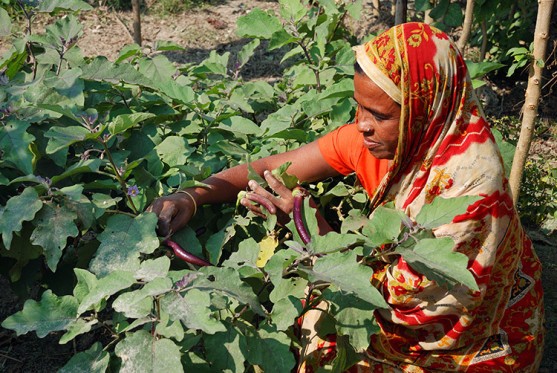By Jolyne Sanjak
When land tenure experts like me write about the connection between land tenure and food security, we often focus on how secure rights to land tend to increase smallholder farmers’ productivity-enhancing investments. As studies in China, Thailand, Ethiopia, Uganda, and Ghana, among other countries, document—farmers with security of tenure are more likely to invest their finances and labor in improvements to their land.
In this post, and in observance of International Women’s Day, I’d like to go beyond this evidence on yields and productive investments to discuss other important ways that land rights, and women’s land rights in particular, intersect with food security.
First, let’s explore some compelling emerging evidence that directly links women’s land rights and food security.
In Ethiopia, children’s caloric intake and body mass index improved in areas where women had more secure rights to land. Furthermore, in the same study, increases in women’s land access decreased household food insecurity by 36 percent.
In Nepal, research has shown that children whose mothers had secure rights to land were 33 percent less likely to be malnourished.
To me, the benefits of secure land rights are clear and rather obvious. Yet, even with increasingly compelling evidence to support this view, a majority of countries around the world have laws or practices that impede women’s access, ownership, and control over land as highlighted in this new infographic. Though more than 400 million women rely on land to feed their children, the majority of these women must access it through the grace of their brothers, husbands, or fathers.
Now let’s look at some indirect ways that improving women’s land rights will impact food security. Particularly noteworthy is the link between land tenure and soil conservation and the impact climate change can have on food security over the long-term.
A study in Rwanda found that women with secure rights to land were 19 percent more likely to invest in soil conservation efforts. While this does not impact food security in the here and now, it has implications for what and how we will be eating tomorrow. Such findings are deeply relevant to the current discourse on feeding the 9 billion people that will live on the planet in 2050.
The interaction between climate change and land rights is increasingly recognized as influential to food security. This is particularly the case for women whose insecure rights to land are most strained by changes in climate.
When land is degraded, not only do farmers reap a smaller harvest, but women are also pushed to use more marginal land that is further from their homes. This means they are spending more time walking to and from their land (and water sources) and their harvests are reduced, impacting household food security.
Another Rwandan study found that land certificate recipients were twice as likely to increase their investment in soil conservation relative to others. Researchers said receiving a land certificate (and thereby enjoying stronger land rights) produced “a very large impact on investment and maintenance of soil conservation measures. This effect was particularly pronounced for female-headed households, suggesting that this group had suffered from high levels of tenure insecurity, which the program managed to reduce.”
With this growing body of evidence, the international development community must recognize the role women’s land rights plays in food security.
I recognize that land rights in general, and women’s land rights in particular, are often seen as an extremely complicated and politically sensitive lever for addressing food security. To counter this perception, below I’ve assembled a few examples of effective interventions that have addressed food security by strengthening women’s land rights:
In Senegal, USAID’s land reclamation project is helping women nourish their families through an interesting model in which communities allocate degraded and abandoned land to vulnerable people, especially landless women. The women restore the land’s productivity using low-tech but highly-effective agricultural techniques. In a few seasons, the land is often healthy enough to produce lucrative and highly nutritious food.
In Uganda and Tanzania, grassroots legal aid is promoting men and women’s awareness of their rights. And, we know that awareness of secure rights to land alone can boost long-term investment in that land, as a number of studies—including a study in Uganda which showed a 20 percent increase in productivity from legal awareness—have indicated.
In India, government allocation of micro-plots is helping women work towards long-term food security for their families.
In Liberia, Mozambique, and Uganda, programs have secured a community’s customary land rights at a low cost. Such efforts can protect large numbers of families at once and can be used to protect common land and forests, which are key resources of critical value to women who forage for food for their families.
These innovative programs, along with the growing body of evidence on the impact of women’s land rights on food security, should compel the international development community to incorporate women’s land rights in their food security initiatives more often and more comprehensively.
Jolyne Sanjak is Chief Program Officer of Landesa.

